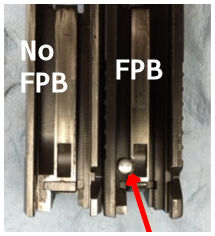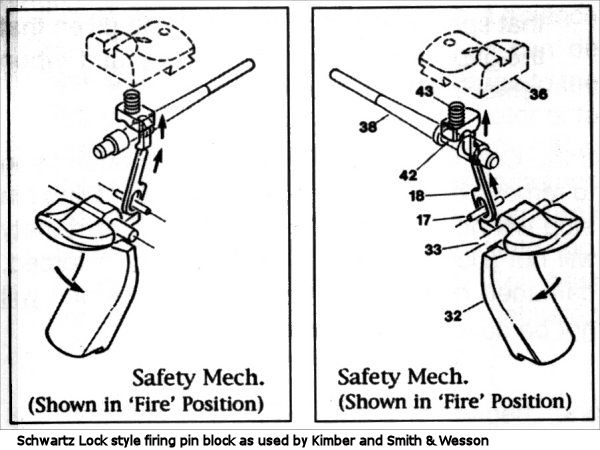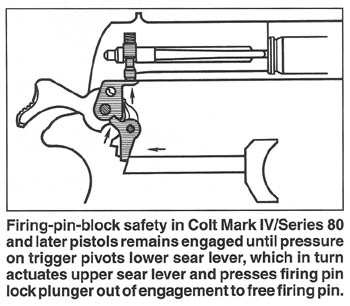About 1911 Firing Pin Blocks:
Series 70 or Series 80?
by Mark Freburg
Before we get to the title matter specifically let's lay some background. And before we delve into the 1911 let's simply explain the firing pin block:
The firing pin block is group of connected parts within the firing mechanism that keep the firing pin from moving forward to strike the cartridge primer, and thus prevents firing the round in the chamber until the firearm's user intends to shoot. It is deactivated via a conscious action on the part of the shooter, usually--but not always--by pulling the trigger.
Know that the firing pin in many pistol designs can move freely at all times, restricted from moving forward only by a recoil spring surrounding the pin. This is what's called inertial design, meaning a simple blow to the firearm can cause the firing pin to move forward without the hammer striking the firing pin. Ideally, there should also be something in the design to keep the firing pin from moving until the last moment--the firing pin block. In theory, none of us should object to a firing pin block in place on our pistols, and usually we don't. The vast majority of semi-automatic pistols today, both hammer-fired and striker-fired, have a firing pin block, and have had them for decades now.
But then there are 1911s. Even in 2019, some 1911s have firing pin blocks, some do not. Why is this the case?
Those objecting to having a firing pin block (FPB) say there is no need, that as far as they know, that the 1911 has served over a century without one and there has not been a major problem with dropped pistols firing inadvertently. Of course records on this have not been kept so saying this is the case doesn't make it so. When I was a deputy sheriff, one of our deputies dropped a cocked and locked Colt Gold Cup which discharged when it went flying out of his hand and struck the hood of his cruiser during the foot chase of a felon. A single anecdote, but it can happen. There seem to have been a couple tests made on accidental discharges with 1911s including a very old, rather subjective one by the NRA, but public seems to believe the 1911 is unlikely to fire unless dropped hard on the muzzle from great heights. In general the public seems unaware of any serious tests. I'm aware of at least one good one.1 The other aspect of FPBs on 1911s is that some believe that the additional linkage degrades the trigger pull. I'll address that momentarily in my comments on trigger-specific FPBs, as not all operate off the trigger.
It seems that 1911 industry as a whole has decided on whether to use FPB's according to the power of their individual legal department's power over each respective company. While some companies apparently see it as a safety concern, others see it as a complicated non-necessity. Still, as most other pistols in the world today do have FPBs, there is a general push for FPBs on 1911s as well, but it has been only partly successful. Some view this as negative, some positive. Both types of 1911s do sell well. The FPB is clearly important to some buyers, but it is not a driving force. (I don't think any one thing is the driving force with 1911 purchases, however.) I can only conclude that the FPB matters a lot to some people and very little to others. A third reality is likely that some 1911 buyers don't understand the FPB thus it isn't part of their buying decision.

I don't have hard figures in front of me to be able to say production of those 1911s having a firing pin block and those not having one is split 50%-50%, but if I were to guess I'd probably say it is somewhere around an even split. I certainly don't own samples of all the dozens upon dozens of brands made today, so I simply don't know. If you are looking for a new 1911 and want to know what you are looking at, don't trust the salesman, lock the slide back and look at the rear underside of the slide. In the photo at right you'll see the 1911 with an FPB will have the telltale round plunger showing (slide on the right as highlighted by the red arrow). This plunger is absent in pistols without an FPB (slide on the left).
Here are some examples of brands of 1911 pistols I have identified one way or the other:
Some 1911s with a firing pin block:
- Most Colts
- Remington
- SIG-SAUER
- Kimber
- Taurus
- S&W
Some 1911s without a firing pin block:
- Springfield Armory
- Ruger
- Colt (Traditional Series)
- Dan Wesson
- S&W E-Series
- Rock Island Armory
Kimber originally had no FBP when they released the first pistols in the mid-90s (now known as the Series I), then added an FPB later (the Series II). The Kimber FPB is their own version of the Schwartz Lock, originally designed at Colt in 1937, but only used by Colt for a short few years before WWII, then abandoned and never revived after the war (which might tell us something). I read an article that claimed Kimber added an FBP at the urging from law enforcement departments. I found that humorous, as law enforcement seem to have mostly ordered Kimbers without the Kimber FPB, and the military always has, as it's reputed to be trouble prone.
Individual gun owners may have fewer problems with Kimber Series IIs because they apparently never detail strip their Kimbers for maintenance, but the Kimber FPB (and the similar S&W FPB) are difficult to maintain because among other things they require removing the rear sight for complete maintenance. They also require perfect fit of the grip safety and correct hand placement on the grip safety for perfect function. It reportedly took Kimber some years to get this odd firing pin block fully functional before returns stopped coming back to the factory for repair or replacement. I'll be fair to the reader here and say I'm not a fan of Kimber 1911s. In my opinion they have always seemed to be too flashy and less into substance, and I really dislike their FPB.


Other FPBs, like the far most popular type designed by Colt and known as the Series 80 type, and licensed by them to most everyone else making 1911s with FBPs, is far less problematic and much easier to maintain than the Kimber FPB. The old complaint, still echoed primarily by those who don't use Colt and other FBP-protected brands of this type, is that the Series 80 FPB, which is deactivated by pulling the trigger, degrades the trigger pull. Speaking from much experience with 1911 triggers over the decades, I do not find that to be the case. But if one is looking for 1911 triggers below four pounds (which would be considered unsafe for most activities and is not readily available in most new 1911s) made for a NON-active competition-only environment, one can decide a 1911 without an FPB is for him or her--if they are truly bothered by the Series 80 FPB. Aftermarket gunsmithing will likely be required to achieve the ultra-lite trigger, unless a semi-custom or custom pistol is ordered. For any other use, I can't imagine anything at all wrong with the current FPB-equipped product being made by Colt or Remington, for example, whose triggers I have used because I own those pistols. And mine are factory stock. Note I don't tolerate excessive take-up or creep, or excessive over-travel. These are good 1911 triggers. But my guns are self-defense oriented, also suitable for action pistol sports--but not Bullseye shooting guns.
As to 1911s without an FPB, most manufacturers these days do tacitly acknowledge the possibility of the inertial firing pin of the 1911 moving forward accidentally to fire the pistol when not intended, so to combat this danger they use a lighter firing pin made of titanium instead of steel, and an extra power firing pin spring (a spring with more power than the original Colt/US Army specs). This combination seems wise and I use it in my personal 1911s which don't have an FPB. It's also a good anytime upgrade if you have any older 1911s without an FPB, and should always be done when updating worn out parts.
So let's talk about the commonly mentioned "Series 80 vs Series 70." I waited until now to get into this because the meaning behind this was far more important than what the industry calls things. But now that you know the background regarding firing pin blocks you also need to know the nomenclature you'll hear from 1911 makers, gunwriters, and gun shop salespeople--as none of these people really talk about firing pin blocks (FPB)s. They couch everything in terms of "Series 80" and "Series 70" and they expect you to know what they mean even you are shopping for your first 1911 pistol. So let's explain it.
You already know that the FPB devised by Colt is referred to as the Series 80 system by many. Since it is used by many different companies, Series 80 has become slang for any 1911 pistol with an FPB, although it should only apply to a 1911 with the Colt Series 80 system. A Kimber for example sure as heck doesn't use a Series 80 FPB, but it does have an FPB--a Schwartz Lock FPB. TMI for some folks.
And, to keep things simple the industry adopted the name of Colt's previous series of 1911 pistols, those sold before the Series 80, called the Series 70, which did not have the FPB, to refer to any 1911 without an FPB. This is ridiculous if we analyze it. No 1911 from the first USGI Model 1911 made before WWI or any older commercial model had an FPB, to include all those thousands of Colts preceding the Colt Series 70, so "Series 70" is an odd choice here. In addition to that, the actual Colt Series 70 had a unique feature, a collet-style barrel bushing only ever found on the Colt Series 70 pistols (the bushing had spring-like fingers rather than being a solid tube). If a "Series 70 style" 1911 was truly an accurate description it would mean a 1911 with a collet bushing, which no modern, so-called "Series 70" style pistol has--but of course most people don't mean that, likely don't even known about that feature.
Nevertheless, that's where we are. Series 80 simply means a 1911 with firing pin block, Series 70 means a 1911 without a firing pin block. Obviously your writer here doesn't care for the nomenclature but I don't make the rules. The primary reason for this is because, prior to the late 1980s, if you wanted to buy a 1911 at all, there was only Colt, with a very few small, mostly unsuccessful competitors that came and went, mostly in the 1960s and 70s. In that regard it is somewhat fitting that the generic names for 1911s without and with an FPB are named after the two series of Colt offerings where in-between that change was made. I'll grudgingly acknowledge that.
I would be remiss if I didn't discuss my preferences and reasoning when it comes to firing pin blocks. As I mentioned above I don't find the Colt Series 80 system the least bit onerous or troublesome. Nor do I find the triggers problematic. You will find people who say the Colt system adds a pound to the trigger pull. That's simply exaggerated and untrue. Unfortunately you'll find older diehard 1911 fans who simply can't accept the change the FPB brought to Ol' Slabsides are to this day hanging on to the silly untrue rumors that somehow still cling to the Colt FPB. Ignore the exaggerations. A Series 80-equipped 1911 can have a trigger pull equal to a non-FPB 1911. You can't tell the difference shooting it.
So it's my belief that if you keep or carry a 1911 pistol for any kind of serious social use like self-defense, you are smart to choose one with a firing pin block, and frankly I wouldn't choose anything other than the Colt Series 80-style FPB. I may be an old fool in some folk's minds but I don't think the US military and all the police departments were wrong in insisting not to trust the Kimber-style grip safety system. But the Colt system gives me peace of mind.
That said I have owned and used the so-called Series 70 types for decades and won't rid myself of perfectly good 1911 pistols because they don't have a firing pin block (In fact I continue to acquire both types for various purposes). For a range gun used for target shooting or plinking it really doesn't matter much, and today a good quality name brand "Series 70" type pistol will have a lightweight firing pin and heavy duty firing pin spring to make up somewhat for the lack of an FPB. Ruger, Springfield, and so forth are good examples. All non-FPB 1911s used for self-defense should absolutely and without question have a lightweight firing pin, and a heavy duty firing pin spring.
So there you have it. I'm not going to say one 1911 option is better than the other, but I do believe you should understand possible consequences and make intelligent choices, and not be swayed by gun store clerks and Internet commandos. Be safe and enjoy your 1911 pistols.
1 One excellent series of 1911 drop tests you should read can be found in the book The M1911 Complete Assemby Guide by Walt Kuleck & Drake Oldham (see Amazon). The test was done and reported on by Drake Oldham (Drake's Gun Works) and can be found in Appendix Five. If you have read other, more superficial testing, or listened to some Internet "authority" write that 1911s cannot fire unless dropped from some absurd height, please read Drake's thorough tests. You may decide to reassess your beliefs on this topic.


markfreburg
Uploaded: 8/18/2019

